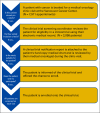Screening intervention to identify eligible patients and improve accrual to phase II-IV oncology clinical trials
- PMID: 23942936
- PMCID: PMC3710186
- DOI: 10.1200/JOP.2012.000763
Screening intervention to identify eligible patients and improve accrual to phase II-IV oncology clinical trials
Abstract
Purpose: Low enrolment rates in clinical trials present a barrier to the development of novel cancer therapies. Currently, only 3% of patients with cancer participate, and many studies fail to achieve necessary enrolment. The objective of this study was to evaluate whether a screening intervention to identify potentially eligible patients (PEPs) would increase accrual rates.
Patients and methods: Over a 4-month intervention period, PEPs for 21 phase II-IV breast, gastrointestinal, genitourinary, gynecology, and lung cancer trials were identified by a screening coordinator. This individual reviewed the electronic medical records of patients attending outpatient clinics and flagged PEPs for 10 medical oncologists at the BC Cancer Agency. Patients who were already documented to be trial eligible by physicians were not flagged. Oncologists were surveyed regarding the helpfulness and accuracy of the intervention.
Results: During the intervention period, 73 patients were enrolled, compared with 61 patients enrolled in the 4 months prior and 51 patients in the 4 months after. A total of 2,098 charts were reviewed, and 120 PEPs were identified during the intervention period, resulting in 19 PEPs who enrolled and four PEPs who declined a clinical trial. Relative accrual rates adjusted for oncologist appointments were 0.85 (P = .15) before and 0.70 (P < .005) after, relative to the intervention period. Oncologist-returned surveys indicated that 67% of flags were helpful, and 70% were accurate.
Conclusions: In this study, manually screening patient records increased enrolment to specific clinical trials. A screening intervention process, involving a dedicated screening coordinator, should be considered to improve clinical trial accrual.
Figures



References
-
- National Cancer Institute. Clinical trials search results. //www.cancer.gov/clinicaltrials/search.
-
- Go RS, Frisby KA, Lee JA, et al. Clinical trial accrual among new cancer patients at a community-based cancer center. Cancer. 2005;106:426–433. - PubMed
-
- Murthy VH, Krumholz HM, Gross CP. Participation in cancer clinical trials: Race-, sex-, and age-based disparities. JAMA. 2004;291:2720–2726. - PubMed
-
- Ehrlich PF, Newman KD, Haase GM, et al. Lessons learned from a failed multi-institutional randomized controlled study. J Pediatr Surg. 2002;37:431–436. - PubMed
Publication types
MeSH terms
LinkOut - more resources
Full Text Sources
Other Literature Sources
Research Materials

